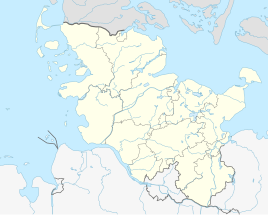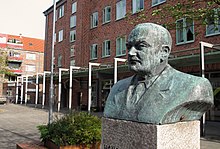Böcklersiedlung-Bugenhagen
|
Böcklersiedlung-Bugenhagen
City of Neumünster
Coordinates: 54 ° 4 ′ 39 ″ N , 9 ° 57 ′ 28 ″ E
|
||
|---|---|---|
| Residents : | 6626 (2007) | |
| Incorporation : | March 5, 1950 | |
| Postal code : | 24537 | |
| Area code : | 04321 | |
|
Location of Böcklersiedlung-Bugenhagen in Schleswig-Holstein |
||
|
Böcklersiedlung, Kantplatz (north side)
|
||
Böcklersiedlung-Bugenhagen is a district of Neumünster in Schleswig-Holstein . It was built on March 5, 1950 as part of the ERP program “10,000 refugee apartments” as the largest single project in the special program; Hans Böckler laid the foundation stone . In 2007 there were 6,626 people in the Böcklersiedlung.
geography
Böcklersiedlung-Bugenhagen lies in the west of Neumünster. The district borders on the Gartenstadt district in the north, the city center in the east and Faldera in the south . It also borders the city forest.
history
The planning of the Böcklersiedlung took place against the background of the extensive destruction of Neumünster in World War II and the reception of numerous displaced persons . The district was created with the laying of the foundation stone on March 5, 1950 on 70 hectares of land that originally belonged to the airfield . The laying of the foundation stone of the Böcklersiedlung on the large construction site in Neumünster, as the first project of the special program, is also considered the structural start of the systematic social housing promotion in the Federal Republic of Germany after the Second World War . The land was provided by the federal property administration and the city. At first 800 apartments were built. Kantplatz was built as the central location of the settlement and retail center. There were also banks, shops, churches, kindergartens and schools. The topping-out ceremony was held on September 2, 1950 .
The German Federation of Trade Unions , which endeavored to apply for and distribute the funding and participated in the organization, had great merit in the construction of the district . Its chairman at the time, Hans Böckler, gave the settlement its name and laid the foundation stone. A bust of Hans Böckler was erected on Kantplatz.
Many of the new residents of the Böcklersiedlung moved from the Nissenhütten on Ehndorfer Platz in the Faldera district. Almost all of them came as refugees from the former German eastern territories or from the Soviet occupation zone . For this reason, numerous streets were named based on these areas.
In 1964 the settlement was expanded to 1,800 apartments. 50 years after the founding of the new district, the rather simple apartments were renovated. By merging smaller apartments, larger ones were created and they were equipped with balconies.
education
The Böcklersiedlung has three schools: the Hans-Böckler-Schule (elementary and community school ), the Walther-Lehmkuhl-Schule (regional vocational training center for trade and technology) and the Wilhelm-Tanck-Schule (community school).
Attractions
The Evangelical Lutheran Bugenhagen Church was built between 1962 and 1963 and is a listed building.
literature
- City of Neumünster (Ed.): Station 9 - The Böcklersiedlung ; In: History (s) from the city forest - A cultural-historical information path through the natural experience area Stadtwald Neumünster ; Neumünster 2006; P. 38 ( pdf )
- Astrid Holz, Dietmar Walberg, et al: Settlements from the 1950s - modernization or demolition? Methodology for making decisions about demolition, modernization or new construction in settlements from the 1950s. Final report. Federal Office for Building and Regional Planning -BBR-, Bonn (sponsor); Working group for contemporary building e. V., Kiel (executive body); Construction Research Report No. 56; Kiel 2006. ISBN 978-3-8167-7481-5
- Ulrich Haake; Ministry of Labor, Social Affairs and Displaced Persons of the State of Schleswig-Holstein (Ed.): “10 Years of Housing Construction in Schleswig-Holstein 1946 - 1956”, Kiel 1956
- Working group for contemporary building e. V. (Ed.): Johannes Scharre / Ulrich Haake: "The construction of 10,000 refugee apartments in Schleswig-Holstein (ERP special program 1950) - results, methods, experiences and conclusions", / Arbeitsgemeinschaft für Produktktiv refugeeshilfe e. V .; (Research report on behalf of the Federal Ministry for Housing No. 148 (2404/05)); Building research report of the working group for contemporary building e. V. No. 2, Kiel 1952
- Working group for contemporary building e. V. (Ed.): Haake, Ulrich: “Reduction of building costs through standardization and typing - ERP experiences”; Bulletin No. 40, Kiel 1953
Individual evidence
- ↑ Marianne Dwars, Klaus Fahrner, Bärbel Nagar (eds.): Neumünster Lexikon. Wachholtz, Neumünster 2003, ISBN 3-529-01711-6 , p. 21.
- ↑ http://www.schleswig-holstein.de/cae/servlet/contentblob/638954/publicationFile/LfD_DListe_sum_bis2007.pdf , p. 49



